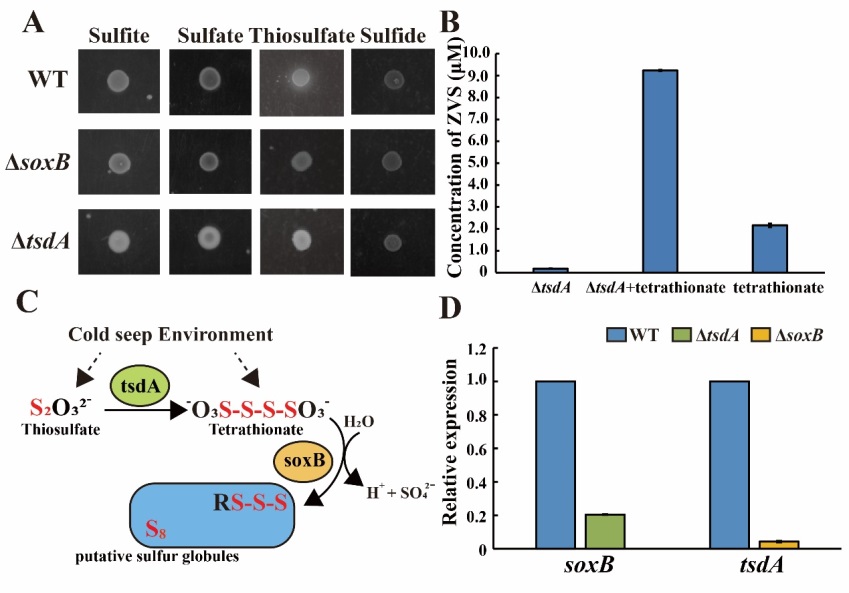Recently, the research team led by Prof. SUN Chaomin from the Institute of Oceanology of the Chinese Academy of Sciences (IOCAS) verified that Erythrobacter flavus (E. flavus) 21-3 formed zero-valent sulfur (ZVS) in deep-sea cold seep through in situ cultivation.
The study was published in microbiology on July 19.
Sulfur is a key element whose transformation and status in the environment are critically dependent upon microbial activities. In previous study, zero-valent sulfur (ZVS) has been shown to be a major sulfur intermediate in the deep-sea cold seep of the South China Sea, the researchers described a novel ZVS-producing pathway determined by thiosulfate dehydrogenase (TsdA) and thiosulfohydrolase (SoxB) mediating the conversion of thiosulfate to ZVS in the deeps-sea E. flavus 21-3. However, because huge difference between laboratory and in situ environment, whether in situ bacteria perform sulfur metabolism as they were cultivated in the laboratory should be further confirmed.
To investigate whether E. flavus 21-3 produces ZVS in the deep-sea cold seep using the same pathway, the researchers in situ incubated E. flavus 21-3 wild type and mutants missing key genes that determine ZVS formation in the deep-sea cold seep located in the South China Sea for 10 days, and found E. flavus 21-3 could produce ZVS in the deep-sea cold seep through the same thiosulfate oxidation pathway. Based on proteomic, stoichiometric and microscopic results, distinctions between E. flavus 21-3 cultivated in the deep-sea cold seep and laboratory with/without activating the thiosulfate oxidation pathway were compared. They found that this thiosulfate oxidation pathway benefited E. flavus 21-3 to adapt the cold seep conditions. Importantly, ~25% metagenomes assembled genomes derived from the shallow sediments of cold seeps contained both TsdA and SoxB, where presented abundant sulfur metabolism-related genes and active sulfur cycle.
It suggested that the thiosulfate oxidation pathway determined by TsdA and SoxB existed across many bacteria inhabiting in the cold seep and frequently used by microbes to take part in the active cold seep biogeochemical sulfur cycle. "It is a very cross-cutting job. Deep-sea researchers need to comprehensively consider the differences between laboratory and deep-sea in-situ conditions, and conduct more comprehensive experimental verification to truly understand the true life process of deep-sea microorganisms. The progress of these studies requires the cooperation of biology, geology, physical oceanography and other disciplines," said Prof. SUN.
This work was funded by the Marine S&T Fund of Shandong Province for Pilot National Laboratory for Marine Science and Technology (Qingdao), Strategic Priority Research Program of the Chinese Academy of Sciences, Key Deployment Projects of Center of Ocean Mega-Science of the Chinese Academy of Sciences etc.

In-situ photos of the study process and site

Verification of zero-valent sulfur (ZVS) formed by E. flavus 21-3 and mutants that cultured in the deep-sea cold seep
Ruining Cai, Wanying He, Rui Liu, Jing Zhang, Xin Zhang, Chaomin Sun*. (2022). Deep-sea in situ insights into the formation of zero-valent sulfur driven by a bacterial thiosulfate oxidation pathway. mBio, Doi: 10.1128/mbio.00143-22.
Jing Zhang, Rui Liu, Shichuan Xi, Ruining Cai, Xin Zhang, Chaomin Sun*. (2020). A novel bacterial thiosulfate oxidation pathway provides a new clue about the formation of zero-valent sulfur in deep sea. ISME J, Doi: 10.1038/s41396-020-0684-5.
(Text by SUN Chaomin)
Media Contact:
ZHANG Yiyi
Institute of Oceanology
E-mail: zhangyiyi@qdio.ac.cn
(Editor: ZHANG Yiyi)

